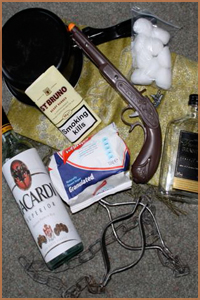Using historical artefacts and random junk stolen from the toy box of a small child.
At one of the many Saturday evening plenary of the Schools History Project Conference I have attended, Ian Dawson demonstrated a revision technique using a table full of mystery objects – some were historical artefacts. Starting with a table covered in cloth, he slowly revealed items and asked volunteers to work out their connection to the historical topic under discussion, (in Ian’s case, Medicine through Time).
This seemed to me like a perfect way to invigorate not only revision but also how we as a department introduce key topics in our Schemes of Work. What follows are some ideas on how to utilise objects, both historical and “simulated”.
The Mystery Table
In an episode of Father Ted, (Flight into Terror), Father Dougal is faced with a terrible dilemma. Standing in the cockpit of an airliner, he wrestles with the urge to push the giant button labelled “Danger, do not push”. Clearly, he pushes and the aircraft jettisons it fuel. It is tapping into this latent desire that, I believe, makes the mystery table such a winner with students.
 As students enter the room, there is a large table in the centre of the room, draped in a sheet. It is obvious from its bulky proportions that something is hidden beneath.
As students enter the room, there is a large table in the centre of the room, draped in a sheet. It is obvious from its bulky proportions that something is hidden beneath.
Students are then divided into pairs and one partner is sent out of the room. I then reveal to the remaining students the items and ask them to memorise them. The others are now re-called and a quick memory game is played with one partner trying to list all the items to their partner.
The next stage of this is crucial as here students are encouraged to make links between the items and elements of their course of study. This is done simply as a Q&A activity with the teacher revealing the item and students being asked to suggest its significance.
Other lessons that could benefit from a Mystery Table component
When teaching lessons on why women finally win the vote in 1918, you can start with a mystery table of objects representing the full range of tactics used by women in the campaign for the vote.
An enquiry on the motivations behind joining the Crusades could use a range of items to show trade goods, land and the promise of a place in Heaven. Finally, we have found that having a GCSE Modern World box is very helpful for revision. This could contain, amongst other things; toy soldiers (military restrictions placed on Germany), a toy horse (Emily Davison), a tractor (the AAA), a wind up monkey (the monkey trial), and an empty gin bottle (Prohibition).
What is crucial to the success of the Mystery Table, is the de-brief. With the revision lessons, things are a lot easier as students are drawing upon pre-existing knowledge. With the slavery and Crusade lessons the key is to work the items into the flow of the lesson.
One simple way to achieve this is to use the items as a starter, as detailed above and then either refer to them as props
during the lesson (carrying them round the trade triangle) or using them as a plenary (items being used to exemplify reasons why people wanted to go on Crusade).
Talking Objects
The British Museum, when launching its interactive display on the objects that best represent human history claimed that “Objects are absent people”.
 This got me thinking that if historical artefacts could talk they would tell very revealing and compelling stories. To this end, as a department we began to acquire a range of interesting artefacts that students could “interview”.
This got me thinking that if historical artefacts could talk they would tell very revealing and compelling stories. To this end, as a department we began to acquire a range of interesting artefacts that students could “interview”.
To date, I have used a Nineteenth Century cavalry sabre, for which I researched the biography of its “owner”, Sir Thomas Trafford; commander of the Manchester & Salford Yeomanry at Peterloo. In addition, through the delights of E-Bay we have also acquired an English Civil War Lobster pot helmet which may have belonged to Oliver Cromwell, Thomas Fairfax or even “Freeborn” John Lillburn.
Finally
I once saw Neil Thompson (ex HIAS History Advisor) demonstrate a lesson using a set of WWII items to play Call my Bluff. Pairs of students were given one of the more mysterious items along with an explanation of its usage. Students were then challenged to come up with two other plausible explanations and challenged to play against their classmates.
As History teachers we work hard to bring the past to life, through film, drama, visuals and interactive teaching methods.
I strongly believe that using artefacts can be a powerful and memorable way to support this vital historical work.
Neil Bates


